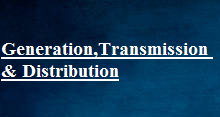Diesel Power Plant Working
Diesel Power Plant Working
A generating station in which diesel engine is used as the prime mover for the generation of electrical energy is known as diesel power station.
For generating electrical power, it is essential to rotate the rotor of an alternator by means of a prime mover. When prime mover of the alternators is diesel engine, the power station is called diesel power station. The mechanical power required for driving alternator comes from combustion of diesel. As the diesel costs high, this type of power station is not suitable for producing power in large scale in our country. But for small scale production of electric power, and where, there is no other easily available alternatives of producing electric power, diesel power station are used.
Basic Principal of Diesel Electric Power Plant
Chemical Energy of Diesel ↔ Heat Energy ↔ Mechanical Energy ↔Electrical Energy
Main Components of Diesel Electric Power Plant:
1. Diesel Engine: It is the main components used in diesel electric power plant for developing mechanical power. This mechanical power we use to run the generator & produce electrical energy. For producing the electrical energy the diesel engine is mechanically coupled to generator. When the diesel fuel burning inside the engine, its start to produce a mechanical power. The combustion of diesel fuel produces increased temperature & pressure inside the engine. Due to this pressure gases are formed, this gas pushes the piston inside the diesel engine, and then mechanical power is produced. With the use of this mechanical power the shaft of diesel engine starts rotating
2. Engine Fuel Supply System: It consists of Fuel Storage Tank, Fuel Filter or Strainer, Fuel Transfer Pump, Day Tank, Heaters & Connecting Pipes. The diesel fuel stored in storage tank. Then this diesel fuel transfer to day tank, the function of day tank is how much quantity of diesel required for 24 hours is store. If the day tank is full or overflow occurs, then excessive diesel returned to storage tank. The filter or strainer is used to purify diesel. With the help of fuel transfer pump the diesel is transfer to day tank.
3. Engine Air Intake System: The air filters are used to supply the fresh air to diesel engine for the purpose of combustion. Engine required fresh air because, if dust particles in the air entered into the engine will cause disastrous effect to valve, cylinder & pistons.
4. Engine Exhaust System: The exhaust gas is removed from engine, to the atmosphere by means of an exhaust system. A silencer is normally used in this system to reduce noise level of the engine.
5. Engine Cooling System: The heat produced due to internal combustion, drives the engine. But some parts of this heat raise the temperature of different parts of the engine. High temperature may cause permanent damage to the machine. Hence, it is essential to maintain the overall temperature of the engine to a tolerable level. The cooling system is required to carry heat from diesel engine to keep its temperature within safe limits. The water pump circulates water to cylinder of diesel engine to carry away the heat. The cooling tower is used for the same water reused. The cooling system requires a water source, water pump and cooling towers. The pump circulates water through cylinder and head jacket. The water takes away heat from the engine and it becomes hot. The hot water is cooled by cooling towers and is re-circulated for cooling.
6. Engine Lubrication System: This system provides lubricating oil to moving parts of the system to reduce the friction between them wear & tear of the engine parts. This system minimizes the water of rubbing surface of the engine. Here lubricating oil is stored in main lubricating oil tank. This lubricating oil is drawn from the tank by means of oil pump. Then the oil is passed through the oil filter for removing impurities. From the filtering point, this clean lubricating oil is delivered to the different points of the machine where lubrication is required the oil cooler is provided in the system to keep the temperature of the lubricating oil as low as possible. It is then cooled through heat exchanger by means of cold water and then it is fed to the engine.
7. Engine Starting System: For starting a diesel engine, initial rotation of the engine shaft is required. Until the firing start and the unit runs with its own power. For small DG set, the initial rotation of the shaft is provided by handles but for large diesel power station. Compressed air is made for starting.
8. Alternator: The diesel engine is coupled to the alternator. The alternator converts mechanical energy into electrical energy. The output from the alternator is given to the bus-bars through transformer, circuit breakers and isolators.


Recent Comments